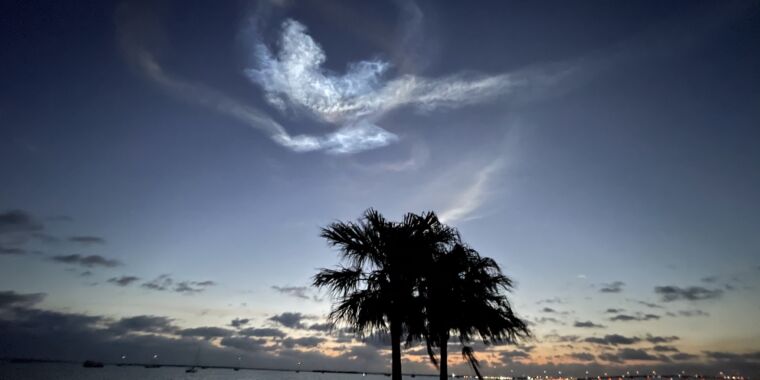NASA gets what it wanted: Independent, reliable access to space

-
Aftermath of the liftoff of the SpaceX Crew-2 mission taking four astronauts to the International Space Station for NASA.
-
The launch took place just before sunrise in Florida.Trevor Mahlmann
-
SpaceX’s Falcon 9 second stage (below) taking the Crew-2 astronauts to orbit as the first stage (middle) fires its cold-gas thrusters to reorient for entry back into the Earth’s atmosphere to land and be used again.Trevor Mahlmann
-
Thrusters.Trevor Mahlmann
-
Lots of thrusters.Trevor Mahlmann
-
Cape Canaveral, Falcon 9 first stage—we read you loud and clear.Trevor Mahlmann
-
Lit from beyond the local horizon by the rising Sun, the plumes appear brightly against the dark background of night on the Florida space coast.Trevor Mahlmann
-
A final view as the second stage (below) nears completion of its second stage burn and the first stage lights up 1, then 3, engines for reentry into Earth’s atmosphere—both descending through the clouds along the horizon.Trevor Mahlmann
-
The plume illumination was lovely.Trevor Mahlmann
In three months, NASA will come upon the 10th anniversary of the final space shuttle flight, a period that was surely melancholy for the space agency.
When the big, white, winged vehicles touched down for the final time in July 2011, NASA surrendered its ability to get humans into space. It had to rely on Russia for access to the International Space Station. And the space agency had to fight the public perception that NASA was somehow a fading force, heading into the sunset.
Now we know that will not be the case, and the future appears bright for the space agency and its international partners. On Friday morning, NASA and SpaceX launched the third mission of Crew Dragon that has carried astronauts into space. After nearly a decade with no human orbital launches from the United States, there have been three in less than 11 months. Another successful mission further confirmed that the combination of Falcon 9 rocket and Crew Dragon spacecraft is a reliable means of getting crews to the International Space Station.
“It took 10 years to get there, to achieve this bold vision for commercial crew,” said NASA’s acting administrator, Steve Jurczyk, during a news conference after Friday morning’s launch. “It’s been amazing what the team has been able to accomplish.”
The “team” is a collaboration between engineers at NASA and SpaceX that have worked to develop and certify the Crew Dragon system for human spaceflight for a fixed price of about $55 million per seat. Since 2017, NASA had been paying Russia more than $80 million for an astronaut to ride into orbit.
The partnership has also been very good for SpaceX, which has sought to develop rapid, low-cost access to space through reusable vehicles. Thanks to NASA’s flexibility, SpaceX launched Monday’s mission on a Falcon 9 rocket that flew in November and on a Crew Dragon vehicle, Endeavour, that first went into space last May.
Betting on reuse
After the launch, SpaceX founder and Chief Engineer Elon Musk said he felt increasingly confident in the prospects of developing a reusable launch system. “It’s only recently that I feel like full and rapid reusability can be accomplished,” he said. “I wasn’t sure for a long time, but I am now.”
With the Falcon 9 and Crew Dragon, SpaceX has gotten mostly there. However, the Falcon 9 rocket’s upper stage is expended after a launch, and the Dragon capsules undergo significant refurbishment between flights. Musk sees this launch system as an interim stage to full reuse, and SpaceX is still learning lessons. The company has already flown one of its Falcon 9 first stages nine times and will soon fly it a tenth time. The plan is to push the limits of the Falcon 9 with the company’s own Starlink missions, Musk said.
“There doesn’t seem to be any obvious limits to the reusability of the vehicle,” he said. “We intend to fly the Falcon 9 rocket until we see some kind of failure.”
These lessons will be incorporated into SpaceX’s next-generation Starship and Super Heavy launch system, which is designed to be fully reusable and able to launch again within days of landing. That’s the aspirational goal, at least. NASA seems intrigued, as it recently selected Starship to land its astronauts on the Moon later this decade as part of the Artemis Program.
During the post-flight news conference, Musk was asked whether the space agency’s aggressive timeline of a 2024 Moon landing was possible. He took a moment to think about this and perhaps ponder all the technological hurdles that must be overcome between now and then to fly Starship down to the Moon safely.
“I think that can be done,” he said. “Yeah, I think so. We’re definitely going to build a lot of rockets and probably smash a lot of them. But I think 2024 will happen. It seems likely. We’re going to aim for sooner than that. This is actually doable.”
So yeah, NASA is not fading into the sunset. Rather, the sun may just be beginning to rise.
https://arstechnica.com/?p=1759680